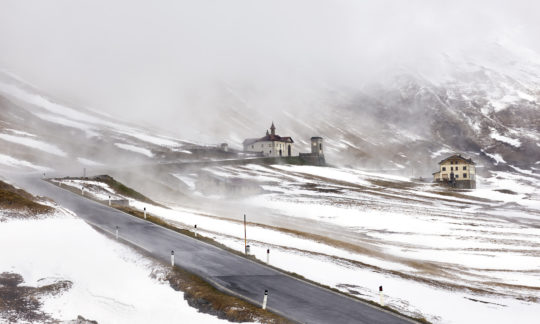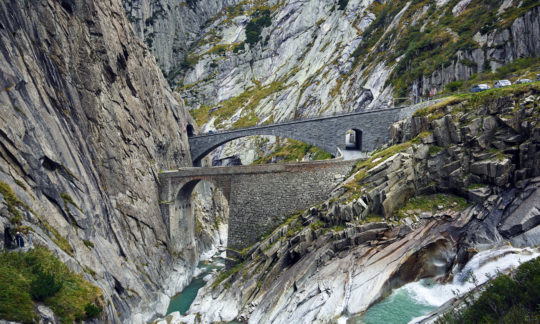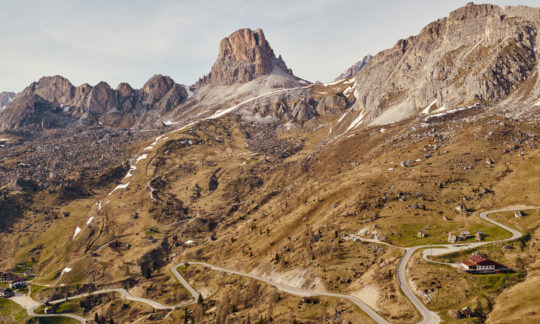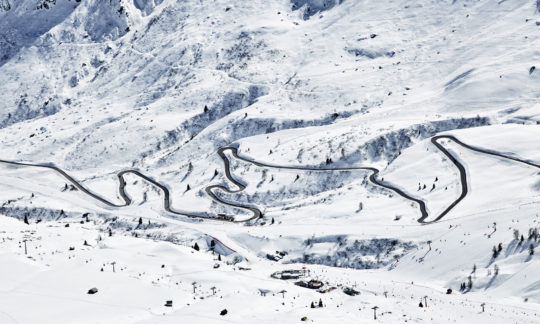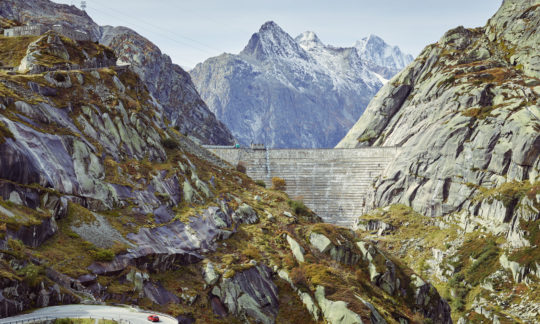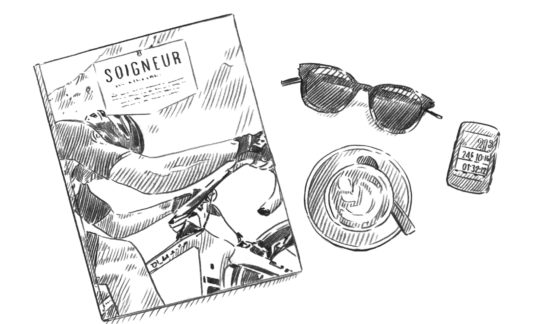The Storied Landscapes of the Dolomites and Swiss Alps
The mystique of the mountains has an eternal pull, drawing us in to explore the twisting ribbons of roads that wrap their jagged and imposing forms.
There has always been an urge to explore and conquer these monstrous peaks, great adventurers finding their magnetic pull irresistible. As far back as the first Tours de France cycling has accepted that challenge too, often on surfaces barely defined as roads on machines barely recognisable as bikes.
We return year after year to revisit the scenes of great victories and supreme struggles, never satisfied that we’ve seen it all. Photographer Michael Blann is a kindred spirit in that regard; a creative with strong ties to cycling and a passion for revealing the true beauty of these harsh landscapes. We spoke to Michael about what these famous mountain ranges mean to him and the inspiration behind his book, “Mountains: Epic Cycling Climbs”.
A snowy scene on the Passo Stelvio. Ride this infamous climb on our Trans & Epic Trans Dolomites trips
Cyclists like to take on the high mountains partly due to their beauty, but largely because of their legend. Your landscape work is imbued with story telling, would you say it’s the drama of cycling in the mountains that inspired the project?
Yes certainly. The landscapes are really just the backdrop to all the stories and dramas that have played out through the history of cycle racing and Grand Tours. It’s something I was very conscious of when I started the Mountains project and dates back to when I was a teenager watching the TDF on the first broadcasts by Channel 4 back in the mid 80’s. All the climbs seemed to have exotic names and I didn’t have any idea of where they were geographically or how they linked to each other. The Mountains project became a process of documenting the climbs and making the link between the physical landscape and the history of the sport. The climbs are almost like battlefields which you have to visit to understand their history. It’s also very much a symbiotic relationship between the physical landscape and cycling. By this I mean the history of the sport gives providence to the Mountain and vice versa. Alpe D’Huez would just be another pass up a mountain but it now has mythical status because of Hinault and LeMond.
The Mountains project became a process of documenting the climbs and making the link between the physical landscape and the history of the sport
With your Getty background you’ve acquired a creative approach that not many photographers have, especially in the studio. Has that background helped the process for the landscape photography?
My time at Getty Images was great and it certainly set me up for the commercial world and has helped establish me for advertising work but I think the landscape work is born out of something much more personal. I believe it’s actually linked to an introverted side of me that likes to roam and explore in my own space. It’s probably the same reason I took up cycling as I think the two disciplines are linked. Ultimately everyone sees the world differently and photography accommodates many genres. I’ve always preferred to stand back and photograph scenes from the perspective of the passive observer which is why my images take a broader view. It’s almost like you can see the action in the distance but you are too far away to hear the noise from the crowd or race convoy.
Feats of engineering punctuate the road on the Gotthard Pass, a key climb on our Epic Trans Swiss trip
What is the process for finding the composition for each shot. We see a lot of repetitive images in cycling, but your perspectives are fresh. I presume there is long research phase behind each shot?
Certainly, my approach has developed over time. When I first started taking landscape shots for the book, I was conscious that most cycling photographers were following the race on motorbikes and because they had to keep pace with the race, they didn’t have time to walk away from the road to get the bigger picture. My photography isn’t about the action, it’s about the landscape within a sporting context so the equipment I use (large format camera) is more in keeping with this methodical approach. It’s not dissimilar to the approach a landscape painter would take.
A ribbon of road snakes along the Passio Giau in the dolomites.
My photography isn’t about the action, it’s about the landscape within a sporting context
What are the practical methods behind a recce and a shoot and just how easy is it to set up a large format camera on a rocky outcrop at 3000m?
Light and creating a sense of drama is very much at the essence of what I do and so I’m very conscious of where the light is coming from which is why I tend to photograph early morning and late afternoon/evening. Finding the best angle and time of day takes research and a recce before I even shoot anything. 3D satellite images on google maps certainly help me to understand the terrain before I visit somewhere but I have found riding a climb is perfect way to recce as I can cover the whole climb and pull in at any point which isn’t so easy in a car. Once I know where I want to be at certain times of day I will hike to the spot with me kit. This is a Phase One Camera with multiple lenses, tripod and computer. I always shoot tethered to a computer so I can check the images I am taking and make adjustments if required. This isn’t always easy as it may involve hiking up steep outcrops so trying to find a stable area to set everything down can be difficult. Also wind and rain are always problematic.
I have found riding a climb is perfect way to recce as I can cover the whole climb and pull in at any point which isn’t so easy in a car
Grey tarmac punctuates the snow on the passo prodoi, which you can ride on both of our dolomites trips
Philippa York (formerly Robert Millar) spoke about fans appearing like Red Indians on the slopes above her
It’s great to have the pro’s stories included in the book. Was it easy to coax a story from them?
It was great interviewing all the professionals in the book and it’s amazing how analytical they were at remembering small details. I found the pros that had been retired a few years were more reflective because they had had time to look back and ponder their careers. They were all very open to being interviewed and it felt like story time for me as I had watched and admired them since I was a teenager and I now had the opportunity to talk directly with them. Guys like Andy Hampsten were fascinating and very thoughtful. He talked about his approach to climbing where he imagined there was a winch pulling him up the climb. Other riders were very much focused on the battle with making the time limit or the environment around them - Philippa York (formerly Robert Millar) spoke about fans appearing like Red Indians on the slopes above them. One of the most emotional stories in the book is by Pedro Horrillo who recounted his brush with death when he crashed on a decent in the Giro D’Italia.
Were there any mishaps, interesting fails, unexpected surprises along the way?
The beautiful thing about landscape photography is that it changes from season to season, day to day and minute by minute. You can wait all day on a mountain for a race to come up and suddenly the weather closes in and your view disappears. Alternatively, a break in the clouds and some magical light can transform a dull scene into something spectacular.
There have also been mishaps along the way. I’ve seen expensive lenses bounce off down the mountain and even a gust of wind take the camera over. I’ve also stepped off 400kg rock only to see it start to roll away. I’ve always been mindful of the terrain though and so far have been relatively lucky.
The Grimsel Pass offers many fairytale scenes, typical of our Epic Trans Swiss trip
I visited the Gotthard Pass several times though before I got the shot I liked. It was late autumn and the grass had turned brown and there was a dusting of snow on the high ground which gave the perfect colour palette.
Do you have a favourite mountain from the project, either from the result point of view or from the story attached to it?
It’s not always the most famous climb that makes the best image. The Gotthard Pass on the cover of the book isn’t really used that much in races except the Tour of Swiss but it has all the elements to make a great picture. I visited it several times though before I got the shot I liked. It was late autumn and the grass had turned brown and there was a dusting of snow on the high ground which gave the perfect colour palette. I also love the Col du Santesch which doesn’t get used as it’s a dead end and also the Grosse Scheidegg which overlooks the north face of the Eiger at the top. There are so many stories linked to the Eiger so when you reach the top you really feel like you are standing in a place of history.
Does each mountain range have a distinct feel, any sort of character that gives each range or each climb its own character?
The Pyrenees are always lush and green on account of being near the warm Atlantic, the Dolomites are rugged, cold and brutal but equally beautiful and the Swiss Alps always feel like passes connecting places but have so much history attached to them.
Mountains: Epic Cycling Climbs
Mountains: Epic Cycling Climbs is a luxury coffee table photography book featuring large format images of the greatest cycling climbs. Photographed over a 6 year period, the project has been a passion that Michael has invested a lot of time, effort and love into. Featuring essays from ex-professionals like Romain Bardet, Greg LeMond, Stephen Roche, Lizzie Deignan, Philippa York, Andy Hampsten and many more, it’s clear that the stories are just as important as the images.
Michael Blann is a professional photographer from Hastings on the South Coast of England. He has been commissioned to create images for some of the biggest brands in cycling, thanks to his distinct talent in capturing the emotion of the sport. Before becoming a photographer Michael spent a year racing bikes for an elite team in Australia with dreams of one day competing in the Tour de France. When he’s not shooting ad campaigns you can still find him riding his bike and dreaming of the Tour. Buy his book or large format landscape print at his website and follow him on instagram and LinkedIn.
You just can’t help but be inspired by Michael’s work, just leafing through his book whets our appetite to ride. Many of the climbs you can see in the book and in his prints feature on our Trans Dolomites, Epic Trans Dolomites and Epic Trans Swiss trips. Whether you relish the challenge of conquering these epic climbs or long to be feel their intangible character up close, we can’t wait to introduce you to their beauty. Read more about the trips themselves below.
Trans Dolomites 2023
Made famous by the Giro d’Italia, the Stelvio, the Gavia, and the Mortirolo are just a few of the legendary climbs you’ll conquer on this magnificent route across the Dolomites and Italian Alps.
Ride the Sella Ronda loop, one of the most famous and impressive bike rides in Europe that includes 4 of the most stunning passes in the Dolomites: the Passo Pordoi, Passo Sella, Passo Gardena and the Passo Campolongo. With legendary climbs including the Passo Giau and Passo Fedaia, this breathtaking trip is one you won't want to miss.
EPIC Trans Dolomites 2023
Our newly designed route concludes with the infamous Monte Zoncolan. Starting under a banner that reads “Welcome to the Gates of Hell”, the Zoncolan, along with the Angliru in Spain, is widely considered the most difficult climb of the Grand Tours.
Make sure you have your climbing legs as we’ll also be riding the infamous Monte Crostis on the same day! We’ve designed one of the hardest routes across the Italian Alps and Dolomites, and you’ll thank us for it.
EPIC Trans Swiss
Nowhere are the Alps more stunning than in Switzerland, and our Trans-Swiss Challenge captures the very best of the Swiss Alps.
Ride the incredible St Gotthardpass – one of the few cobbled passes in Europe – and Grosse Scheidegg – with it’s views of the famous Eiger, one of the most dramatic climbs in Europe. In addition to these 2 unique climbs, you’ll also conquer the Furkapass, Albulapass, Nufenenpass, Ofenpass, Umbrailpass, Grimselpass, and even the Passo Stelvio!
Watch Michael's short film for more of his thoughts and motivation behind shooting the Mountains: Epic Cycling Climbs book. Film by John Ingle



